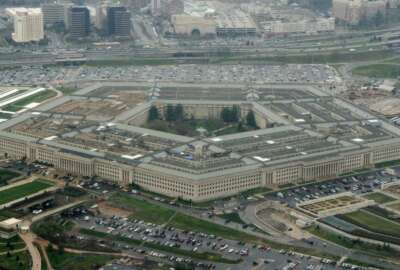
DoD asks for $705B for 2021, gives Space Force more than $15B
The Defense Department is requesting $705.4 billion in 2021 in a budget it says will focus on dominance across the air, sea, land, space and cyberspace by investing...
The Defense Department is requesting $705.4 billion in 2021 in a budget it says will focus on dominance across the air, sea, land, space and cyberspace by investing in joint programs that bring the domains together.
“Future wars will be waged not just in the air, on the land or at sea, but also in space and cyberspace; dramatically increasing the complexity of warfare,” Deputy Defense Secretary David Norquist said Monday during a briefing at the Pentagon. “This budget reflects that challenge by pulling together all of the pieces of the National Defense Strategy that have been built over the past two years.”
The budget, which is largely flat compared to last year’s $718 billion request, will focus on modernizing current systems, building space and cyber programs, accelerating innovation in emerging technologies and builds onto the military’s readiness gains, Norquist said.
Defense budget officials said they made cuts in legacy systems and duplicative processes to redirect money to priorities since there was no budget increase this year.
DoD is also restraining itself from excessive use of the overseas contingency operations fund (OCO) — a pool of money used for bankrolling war efforts, but has been criticized for being used like a slush fund. The base budget request is $636.4 billion, with $69 billion in OCO. DoD admits $16 billion of OCO funding will be used for base budget programs. The Trump administration tried to bypass the Budget Control Act in the 2020 budget by stuffing OCO will base items, ballooning the emergency war fund request to $165 billion.
The 2021 request also pays for a 3% pay raise for military service members, adding on to the 3.1% increase from the 2020 budget.
The budget continues to recognize space and cyber as the connective tissue between the traditional land, sea and air domains, as well as important independent domains in themselves.
Space investments total $14.1 billion, about 15% higher than last year.
“In the space domain, the focus was on enhancing our organizational structure and improving our capabilities including satellite communications capabilities, space-based warning and space launch capacity,” Lt. Gen. Anthony Ierardi, DoD’s resources and assessments director, said.
Cyber shows a 10% increase over last year at $9.6 billion for offensive and defensive capabilities, resilient networks and a multi-cloud environment.
The request uses money to modernize traditional domains as well.
About $57 billion will go to air superiority, buying more fourth- and fifth-generation aircraft and buying more KC-46 tankers and Apache helicopters. In the sea, $32.3 billion will go to increasing the fleet size to 309 by 2025, and funding advanced long-range missiles. For the land domain, $13 billion will pay for new combat and tactical vehicles and close combat advancements like visual augmentation and night vision.
The budget puts $125 billion toward readiness to fund critical training, increase money for maintaining and expanding the readiness of the Navy fleet and increasing Air Force flying hours. It also increases military end strength by 5,600 over 2020 levels.
Research and Development
The request continues the Pentagon’s historically large asks for research and development. DoD wants $106.5 billion for R&D, beating out last year’s $105.4 billion appropriation as the largest in 70 years.
Part of that funding will go to emerging technologies that DoD feels are needed to maintain an edge over countries like China and Russia.
The R&D budget gives $3.2 billion to hypersonics, $1.5 billion to microelectronics, $1.7 billion to autonomous vehicles and $800 million to artificial intelligence.
The Air Force will see a significant decline in its R&D funding as the Space Force takes over some of the responsibilities.
The Air Force R&D budget is $37.4 billion, compared to $45.7 billion last year. That’s because $10.3 billion of what used to be Air Force spending for R&D will now be under Space Force control.
The Air Force still gets the most research spending out of all of the services. About $24 billion will go to defense-wide research, $12.8 billion will go to the Army and 21.5 billion will go to the Navy.
Space Force
This is the first budget request since the creation of the Space Force at the end of 2019. Space Force is allocated $15.4 billion for 2021, that’s compared to just $40 million in 2020. Outside of the $10.3 billion for R&D, the new service will get $2.6 billion for operations and maintenance and $2.4 billion for procurement.
All of that money comes from the Air Force budget.
The Space Force will grow from 160 military and civilian personnel to nearly 10,100 in 2021. The total service member end strength will be about 6,400.
“The U.S. Space Force stand-up, which began in 2020, will continue through 2025,” the DoD budget overview states. “Most personnel who were previously assigned to Air Force Space Command, a former major command within the U.S. Air Force, are now assigned to the U.S. Space Force to perform its missions.”
Response
Congressional Republicans do not seem excited about the Trump administration’s defense budget.
“The Department of Defense budget request makes it clear that the current budget agreement is insufficient to ensure that our military can implement the National Defense Strategy and make the investments it needs to outpace our adversaries,” Sen. Roger Wicker (R-Miss.) wrote in a Monday statement. “Congress and the administration should come together to fund the defense department at a responsible level, which senior defense leaders have said is 3% to 5% above inflation annually.”
House Armed Services Ranking Member Rep. Mac Thornberry (R-Texas) shared Wicker’s view.
“At a time when senior commanders and national security experts have repeatedly called for 3-5% real growth through 2025, DOD’s resources are essentially unchanged from last year’s levels,” Thornberry said in a statement. “To compensate, Defense Secretary Mark Esper and our military leaders are implementing reforms and repurposing resources from lower priority functions to programs essential to the National Defense Strategy.”
Not many Democrats have made comments about the defense budget yet.
House Budget Committee Chairman John Yarmuth (D-Ky.) mentioned it in passing in his broader statement on the budget as a whole.
“The president signed a bipartisan two-year budget deal into law but now, the president is apparently going back on his word,” Yarmuth wrote Sunday. “Instead, he is proposing deep cuts to critical programs that help American families and protect our economic and national security.”
Copyright © 2025 Federal News Network. All rights reserved. This website is not intended for users located within the European Economic Area.
Scott Maucione is a defense reporter for Federal News Network and reports on human capital, workforce and the Defense Department at-large.
Follow @smaucioneWFED





